Gunship Academy
by Richard Sheffield
AH-64A Apache Armament
Rockwell AGM-114A Hellfire missile. The Hellfire missile carries the main punch of the Apache and is a significant improvement over the TOW missile which was originally specified. The TOW is an excellent antitank weapon but has the major drawback of requiring line-of-sight contact with the target for the entire flight. The TOW is a wire-guided system that is flown to the target by the gunner in the helicopter. This leaves the aircraft visible and vulnerable for as long as it takes the missile to reach its target.
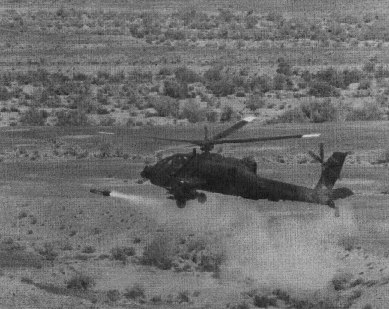
The Hellfire, as proposed, was to be a fire-and-forget weapon (HELicopter FIRE-and-forget), but initial problems with the TV-based guidance system forced designers to consider a laser-tracking system. This system does not provide true fire-and-forget operation but requires that the target be illuminated by a laser for the last portion of its flight.
The important difference between the Hellfire and the TOW is that the laser used to guide the Hellfire does not have to be on the helicopter. Since the Apache can aim at and deliver Hellfire missiles to a target which is illuminated by ground-based or scout helicopter-based lasers, it can hit a target the gunner never sees.
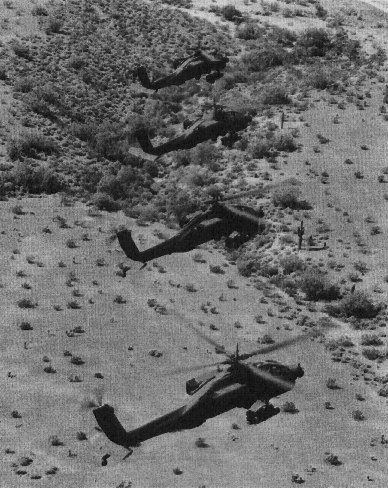
A mast-mounted sight has been developed for just this purpose. This device sits on top of the rotor mast and allows an OH-58 scout helicopter to illuminate targets while hiding behind trees or rocks. The Apache can also fire the Hellfire before the target is in view, by using the lock-on-after-launch mode.
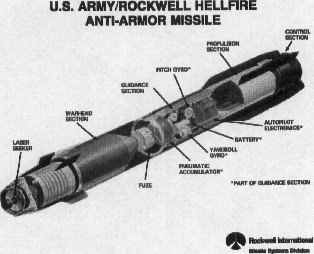
To do this, the gunner launches the missile, and then, several seconds later, the pilot pops up from concealment and illuminates the target for the last few seconds of the flight. This is generally enough time for the missile to lockon to the target and change course.
The whole idea of the Hellfire is to reduce the vulnerability of the aircraft delivering the weapon. The remote designation and lock-on-after-launch capabilities combined with a longer range make the Hellfire a much safer weapon to use than the TOW.
The M230 chain gun. The chain gun, or area weapon, was designed specifically for the Apache. When Hughes Aircraft won the contract to build the AH-64A in December 1976, they were also awarded the contract to produce a gun of a totally new design. Instead of using a multibarrel Gatlingstyle gun as had been the practice, they used the Lanier Linkless Feed System to load the ammunition into a unique rotating-bolt mechanism. This mechanism is chain driven, as opposed to the old method of using the gas created by firing a round to eject the cartridge and recock the gun. That system was prone to jamming if the round did not fire to create the gas. With the chain-drive system, the round gets ejected after the firing cycle whether it fires or not.
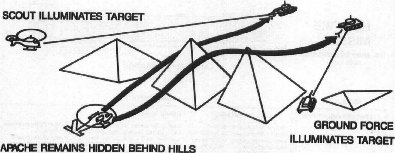
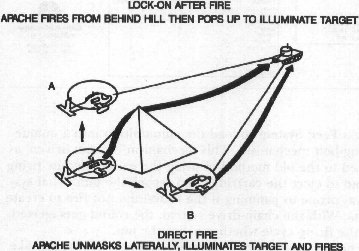
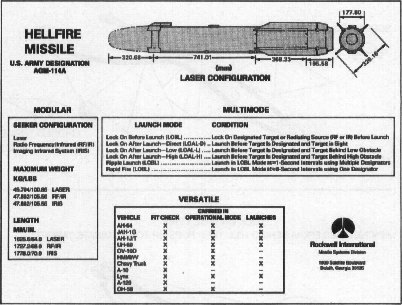
The gun is a 30mm weapon instead of a 20mm gun like the one on the AH-1 Cobra. The increase in size gives the Apache more firing range and killing power against armored targets. Another difference between the Cobra and the Apache is the location of the ammo magazine. In the Cobra, the gun and the ammo were located on the chin of the aircraft under the gunner's station. As the fuel burned and rounds were expended, the weight distribution of the aircraft constantly changed, negatively affecting the flight of the helicopter. To avoid this problem, the ammunition aboard the Apache is stored near the center of gravity in the belly of the aircraft directly under the rotor mast.
Although the 30mm gun is capable of destroying armored targets, the main purpose of the area weapon is to provide suppressive ground fire while the crew carries out their antitank mission. The gun is usually operated by the CPG, but it can be operated by either crew member using the look-and-shoot helmet-mounted sight system.
Aerial Rockets. Folded Fin Aerial Rockets (FFARs) are included in the Apache's arms list as a complement to the short-range gun and the long-range Hellfires. Although these rockets may appear small, they are actually five and a half feet long and carry quite a punch. These unguided rockets were deployed in Korea in an air-to-air role on board F-86 fighters and were among the first arms to be used aboard helicopters in Vietnam. There they proved to be cheap and effective and made the transition from use aboard the UH-1 Huey to the AH-1 Cobra, the first true attack helicopter. Now they've made another transition to the new generation of attack helicopters, the modernized AH-1S and the AH-64A Apache.
The role of the 2.75 FFAR aboard the Apache is similar to that of the 30mm area weapon. It is used to suppress ground fire in an area about to be entered, and, since it has a longer range, it can be used to keep the enemy's head down until the 30mm gun can be employed. The rocket can also be used to attack and destroy soft ground targets which are not vulnerable to Hellfire attack, such as depots and anti-aircraft (AA) gun sites. In emergency situations, it can even be used in an air-to-air role against Hind helicopters.
The FFARs have been constantly improved over the years (a trend that is continuing). New versions are said to contain a submunition warhead. These warheads will disperse a number of M73 grenades, or bomblets, which can defeat prone personnel and light armor over a wide area.
Air-to-Air Weapons. The choice of an appropriate air-to-air missile for the Apache is currently the source of great debate and interservice territorial bickering.
The AIM-9L Sidewinder is by all accounts the best short-range air-to-air missile in the world today. It has been used effectively in 1981 by the U.S. Navy against Libyan fighters, in 1982 by the Israeli Air Force against Syrian jets, and most recently in the Falkland Islands where the British shot down 16 Argentine fighters with niner limas, as they are called.
The Sidewinder was developed by the Air Force however, not the Army, and, in a typical case of interservice shortsightedness, the Army wants to use a weapon developed within their own service. The weapon they have chosen is the FIM-92 Stinger missile. The Stinger was developed by the Army as a shoulder-fired ground-to-air weapon and, as such, is much smaller than the Sidewinder. Due to this size difference, the Stinger is not nearly as lethal as its Air Force counterpart. This is a major consideration since the large and heavily armored Mi-24 Hind and Mi-28 Havoc are the most likely opponents to be encountered over the battlefield in Europe. The main advantage of the Stinger is that, due to its small size, a launcher box containing two missiles can be mounted on each wing. But, if it takes two hits from a Stinger to bring down a Hind, then little is to be gained.
The designers of Gunship have included the AIM-9L as the air-to-air weapon for the Apache, and I think that if the helicopter were to go into combat, the pilots and gunners would insist on carrying the Sidewinder. Using what makes the generals happy during training is one thing, but it is quite another to go into battle and risk your life with an inferior weapon.
Weapons mix. Of course, the Apache crews would love to carry 16 Hellfires, 38 FFARs, and a couple of air-to-air missiles along with a full magazine of 30mm ammo. The Apache, unfortunately, cannot carry everything, and in some weather conditions loads must be further reduced. The following is a list of Army-recommended arms to be carried for various missions in differing climates.
Type of Mission |
Temperature |
Weapons |
|---|---|---|
Antiarmor Mission (Middle East) |
95 degrees |
8 Hellfires, 1200 rounds 30mm |
Antiarmor Mission (Europe) |
70 degrees |
16 Hellfires, 1000 rounds 30mm |
Covering Force (Europe) |
70 degrees |
4 Hellfires, 38 rockets, 320 rounds |
Airmobile Escort (Middle East) |
95 degrees |
38 rockets, 1200 rounds |
Airmobile Escort (Europe) |
70 degrees |
76 rockets, 1200 rounds 30mm |
This list is only a suggestion. Each mission will have different requirements. The important thing to notice is that operating in hot weather will reduce the aircraft's lift ability and reduce the amount of arms you can carry. Overloading the aircraft for the current weather conditions is a dangerous practice—since the loss of one engine could force you to land in enemy territory or to dump valuable weapons.
Table of Contents
Previous Section: Weapons Systems—Theirs and Ours
Next Section: Soviet Weapons
